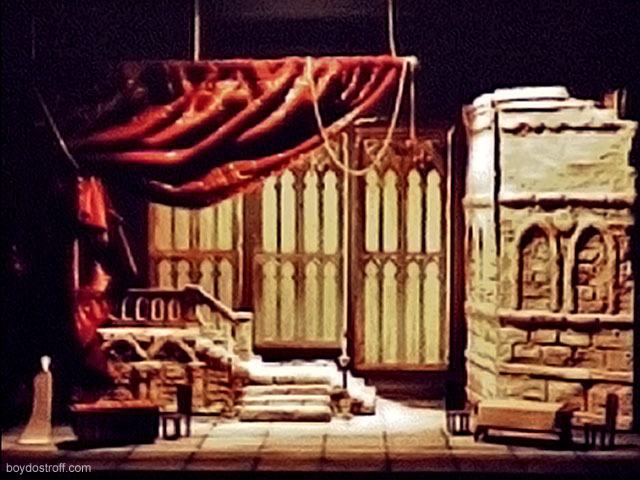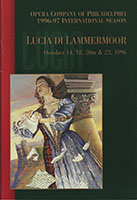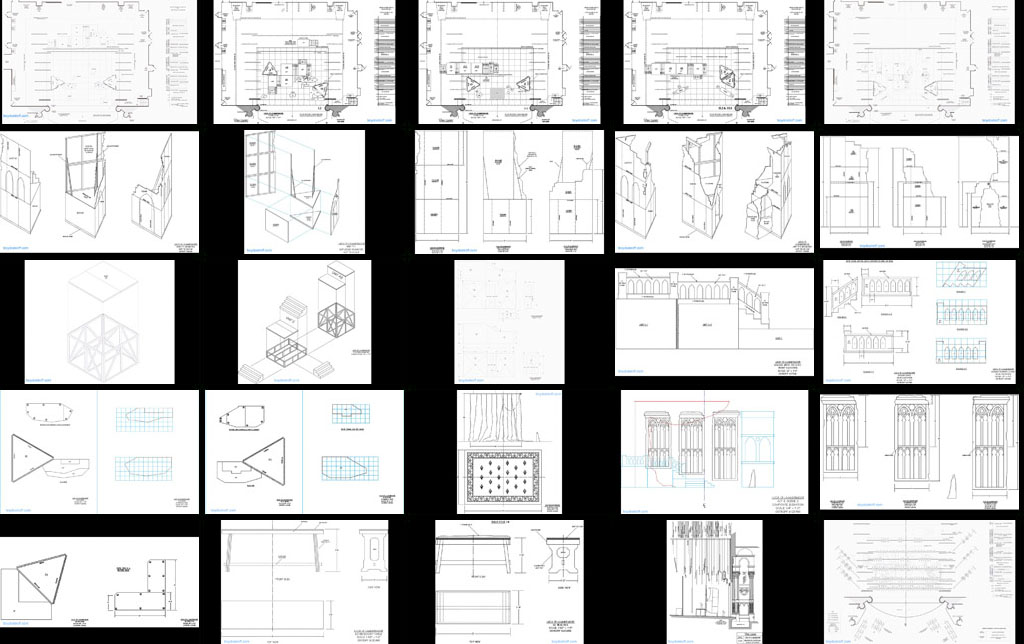Opera Company of Philadelphia • October 14, 18, 20, 23, 1996 at the Academy of Music
Scenic and Lighting Design: Boyd Ostroff • Director: James de Blasis • Costume Design: Richard St. Clair • Hair and Makeup Design: Tom Watson • Conductor: Maurizio Barbacini
Normanno/Arturo: Matthew Bitetti • Lord Ashton: John Hancock • Raimondo: Raymond Aceto • Lucia di Lammermoor: Maureen O’Flynn • Alisa: Suzanne DuPlantis • Edgardo: Stuart Neill

“AT THE CAVERNOUS Opera Company of Philadelphia production center, doors and windows are open to the sun, Sinatra is blaring on the radio, hammers are pounding, staple guns clattering, and a majestic ruined castle is beginning to take shape.
Over in a corner, a young man with a chainsaw is giving a hulking Styrofoam-clad form the look of chiseled stone. In the center of the room, three stage carpenters clamber over a set of towering “stained glass” windows which are constructed out of plywood and yards of plastic strapping. Nearby, a set of massive “stone” fireplaces, a monumental staircase and two ominous coffins — the prone images of their future inhabitants carved on their lids — sit ready for the painter’s brush. In the next room, a pile of what look like giant foam rubber helmets await the special treatment that will transform them into boulders.
This isn’t the sort of scene most people conjure when they think about the magic of opera, with its lavish blend of soaring soloists, heavenly choruses, grand orchestrations and high drama. But what could be more magical than turning wood, glue, foam, paint, fabric and a little stage lighting into an otherworldly palace on the Scottish moors? Which is what all of this will become whe it’s rolled onto the Academy of Music stage next month for the Opera Company’s production of Donizetti’s Lucia di Lammermoor.
This kind of sorcery is still something of a new venture for the Opera Company, whose production center got its start in 1994 building an innovative rainforest set for The Magic Flute. After two moves — from a rented space in New Jersey, to the basement of the old Bulletin building — the workshop has found a new long-term 14,000-square-foot home at the former Frankford Arsenal (now known as the Arsenal Business Center). And in July, the Opera Company received a $495,000 grant from the William Penn Foundation that will help upgrade the production center over the next three years.” – Eils Lotozo, “Opera Company Constructs a Sound Future”, Philadelphia Weekly, 9/18/1996
“Opera Company of Philadelphia work crews spent much of last week setting up scenery for Donizetti’s Lucia di Lammermoor at the Academy of Music. The company will present the opera on four nights this month, starting a week from tonight. The massive 17th-century Scottish castle that is the setting for Lucia was designed and built by OCP production people in space it leases at the Arsenal Business Center, off Interstate 95 in Frankford.
Stored at the center are carefully crafted bits of scenery for various operas — anvils for the chorus in Il Trovatore, trees for The Rake’s Progress, a lion carved in styrofoam for Salome…
Boyd Ostroff, director of production heads the work, assisted by Kevin Baratier, scenic coordinator. James de Blasis is stage director for Lucia di Lammermoor. The Philadelphians not only construct elaborate sets for their own use; they also lease them to opera companies throughout the United States and Canada. ‘Opening our own shop has been a tremendous asset for us,’ said John Callahan, OCP’s head carpenter and technical director. ‘We haven’t even gone into marketing, and everybody’s calling us.’” – Peter Binzen on Business, “Opera Company is setting the stage for its continued success”, The Philadelphia Inquirer, 10/7/1996
Designer’s Model
Production Photos
Backstage Photos
Shop Photos
Design and Technical Drawings
 Production Staff
Production Staff
Director of Production: Boyd Ostroff • Asst Production Director: Shima Orans • Scenic Coordinator: Kevin Baratier • Lighting Coordinator: John S. Hoey • Stage Manager: Tara Kovach • Asst Stage Managers: Geren Raywood, Lori Aghazarian • Costume Director: Richard St. Clair • Asst Lighting Designer: Michael Voytko
Technical Director: John Callahan • Properties Coordinator: Lou Petrucci, Jr • Master Electrician: Michael Hennessy • Asst Electrician: Mark Petrucci • Flyman: Timothy Callahan
Shop Carpenters: John Callahan, Matthew McIntyre, Paul Lodes, Thomas Bowen, Timothy Callahan, William Ringland. James Casey, Ed Garvey
Scenic Artists: Heath Baratier, Jacob Heise, Paul Santoleri, Sarah Baptist, Thom Bumblaskis
Scenery Data
- Built Aug-Sep, 1996 at the Opera Company of Philadelphia Production Center / Frankford Arsenal
- Scenery construction budget: $100,900 • Actual cost: $95,732 • Total rental income: $10,000
- Load-in crew: 16 • Run Crew: 16 (carpenters, flymen and props only) • 8 hours required for load-in • 1 truck required for shipping
- This production no longer exists
Production History
Opera Company of Philadelphia • October 14, 18, 20, 23, 1996 (premiere) at the Academy of Music • Scenic and Lighting Design: Boyd Ostroff • Director: James de Blasis • Costume Design: Richard St. Clair • Hair and Makeup Design: Tom Watson • Conductor: Maurizio Barbacini
Indianapolis Opera • April 11, 13, 1997 at Clowes Memorial Hall • Scenic Design: Boyd Ostroff • Conductor: James Caraher




